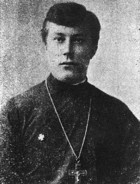Life and Services for St. John of Tsarskoye Selo and Chicago
Missionary to America
Builder of Holy Trinity Cathedral
First clergyman martyred in the Russian Revolution
Feast: October 31
Troparion and Kontakion texts (Moscow Patriarchate, 1994)
Full service texts (Daniel Manzuk, 2004)
Molieben and Akathist texts (Daniel Manzuk, 2006)
Full service texts (Daniel Manzuk, revised 2010)
Vespers and Liturgy texts, traditional English (Hierodeacon Herman, 2014)
General Service to a 20th Century Russian Hieromartyr, Slavonic (Moscow Patriarchate, 2003)
Magnification music - (L’vov-Bakhmetev)
Magnification music, traditional English - (L’vov-Bakhmetev)
Magnification music - (Znamenny, Ledkovsky)
Magnification music, traditional English - (Znamenny, Ledkovsky)
Additional resources at OCA.Org – music, photos from canonization, text of canonization
St. John Kochurov
Missionary to America and First Hieromartyr under the Bolshevik Yoke
Saint John was born to a priest’s family on July 13, 1871.
He enrolled in the Ryazan Seminary where he showed great promise, excelling in his studies. He furthered his education by enrolling in the prestigious St. Petersburg Theological Academy, completing his formal education and graduating in 1895.
Very shortly after graduating from the Academy, St. John married. Later that summer, on August 27, 1895, at the St. Alexander Nevsky Lavra in St. Petersburg, he was ordained to the holy priesthood by Bishop NICHOLAS (Ziorov) of the Aleutians and Alaska.
Coming to Chicago
Saint John eagerly expressed a desire to be a missionary priest in far-off America and shortly thereafter he was granted a transfer to the United States and assigned to be the first permanent priest to serve St. Vladimir’s Church — eventually to become Holy Trinity Cathedral. (The community had been served periodically by St. Alexis Toth of Minneapolis.)
Saint Vladimir’s Church community did not have its own church building yet. At the direction of St. Tikhon, St. John contracted architect Louis Sullivan to design a temple for the community to use and construction began in April 1902. He sought and received donations from Tsar Nicholas II and wealthy Chicagoans including Harold McCormick and Charles R. Crane, the American Minster to China. For the laying of the cornerstone, a choir from St. Mary’s in Minneapolis under the direction of Professor Zaichenko came for the august occasion and he personally oversaw the construction. In 1903, St. Tikhon consecrated the newly completed building.
Working beyond Chicago
Saint John, along with St. Alexis of Minneapolis were two of the more influential priests in the united brotherhood Russian American Orthodox Mutual Aid Society (later, Russian Orthodox Church Mutual Aid Society/ROCMAS).
While serving St. Vladimir’s, our holy father John also devoted great efforts toward the establishment of other churches. He performed the first services for the Orthodox community on Chicago’s south-west side which eventually would become Archangel Michael Orthodox Church. Beyond the immediate vicinity of Chicago, St. John was also instrumental in forming numerous other parishes including Nativity of the Virgin Mary in Madison, IL (1900), Three Saints in Streator, IL, St. Nicholas in Joliet, IL (1907), in addition to Buffalo, NY and Heartshorn, OK.
Administrative Work
He also worked in the field of translating religious texts into English, providing for the future of a Church that would not be populated predominantly by immigrants but English speaking native-born Orthodox.
His administrative abilities, put to use by founding parishes and serving as Dean of the central states, were also helpful in helping to organizing the historic first All-American Sobor, convened by St. Tikhon at Mayfield, PA in 1907.
Return to Russia
In 1907, he returned to Russia and due to his skills in education he was assigned to teach catechism in the schools of Narva, Estonia, where, as in America, the Orthodox were a minority.
In 1916, he was assigned to St. Catherine’s Cathedral in Tsarskoye Selo (near Petrograd), where his skillful and moving sermons attracted many people.
Martyrdom
On October 30, 1917, as the town was under attack by the Bolshevik forces during the turmoil of the Russian Revolution, people thronged to the churches seeking consolation. The clergy conducted a prayer service and procession throughout the town to pray for peace.
The following day, the town was seized by the Bolsheviks and St. John was arrested, taken to the outskirts of town and shot to death. He thus became the first clergy martyr of the Russian Revolution in 1917.
Several days following his death, St. John was buried in the crypt of St. Catherine’s Cathedral, which was later demolished some years later.
Epilogue
On December 4, 1994, St. John was canonized by the Council of Bishops of the Russian Orthodox Church. In Russia, he is venerated as the first of the new martyrs of the 20th century, while in America, he is additionally remembered as a missionary and inspired preacher.







